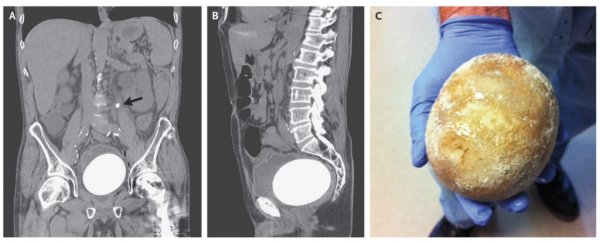A 64-year-old man has had to have a bladder stone nearly as big as an ostrich egg surgically removed at a hospital in the US.
The man had been experiencing pain in his left side and reported having trouble urinating for three days, so he went to the emergency room at St. Mary Medical Center Long Beach.
There, a CT scan revealed not one, but two stones. A small stone in the ureter connecting his left kidney to his bladder, and an absolute monster of a stone in the bladder itself.
It clocked in at 12 by 9.5 by 7.5 centimetres (4.7 by 3.7 by 3 inches) and weighed 770 grams (1.7 pounds). That's not quite as big as an ostrich egg, which at its largest can measure up to 15 centimetres long (6 inches) and weigh up to 1.5 kilograms (3 pounds), but it's not far off.
Bladder stones, which are not to be confused with kidney stones, are usually caused by bladder inflammation. This occurs when the body is dehydrated or the urine is too concentrated, causing it to form crystals in the bladder. Over time, these build up, forming a larger and larger stone.
Most won't get to this size, though. The patient was a special case. After agressive bladder cancer over 10 years ago, surgeons had removed his bladder, and constructed a new one out of pieces of intestine.
This is called a neobladder, and it's particularly susceptible to stone disease. Over the years, multiple cases have demonstrated that neobladder stones can form with very few symptoms, which allows them to grow to tremendous size before the patient notices something wrong.
A case described in 2004 talks about a woman with a neobladder stone 10.5 by 7 by 7 centimetres (4.1 by 2.7 by 2.7 inches), weighing 760 grams (1.76 pounds), and a 2011 case involved a man with three large stones in his neobladder.
According to Guinness World Records, the largest bladder stone ever was removed from a 62-year-old patient at a cancer clinic in Brazil. It came in at 17.9 by 12.7 cm by 9.55 centimetres (7 by 5 by 3.7 inches), and weighed 1.9 kilograms (4.3 pounds). Ouch.
The St Mary patient had to have his stone surgically removed, although the smaller stone was treatable with lasers. He has had no complications following the procedure, and his doctors are monitoring him for new stones.
The report was published in the New England Journal of Medicine.
